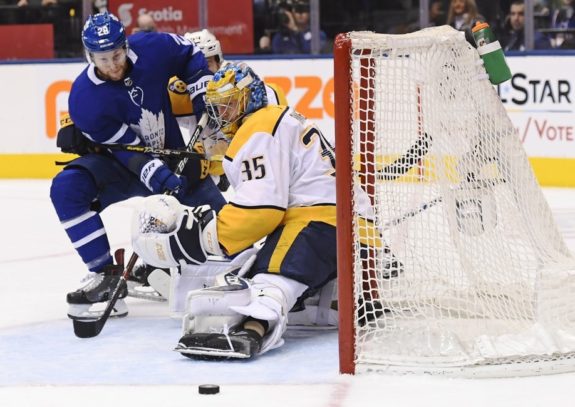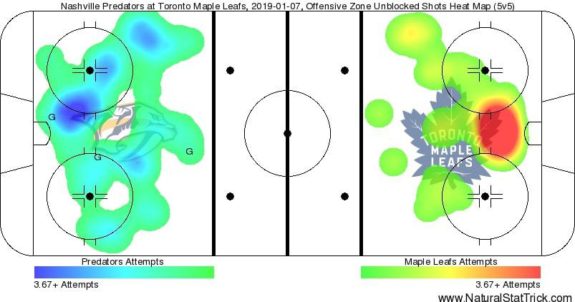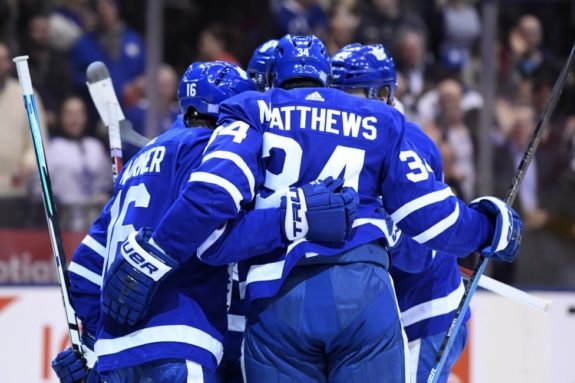On Jan. 7, the Nashville Predators and Toronto Maple Leafs squared off in Toronto at Scotiabank Arena in a game between two of the league’s best teams. The Predators may have emerged with a 4-0 victory, but it was a heavyweight bout between two talented rosters in what could be a preview of the Stanley Cup Final.
Maple Leafs and Predators Entering the Game
Heading into the game, the Maple Leafs and Predators had similar seasons to that point. The Maple Leafs had a 27-12-2 record while the Predators were 25-15-3. Both teams were in second place in their respective divisions.
In their previous five games, the Maple Leafs went 3-2-0 and won their most recent game 5-0 against the Vancouver Canucks two nights earlier. They are a top-five offensive and top-10 defensive team with a top-10 power play and an average penalty kill. They are led by Mitch Marner’s 15 goals and 55 points and John Tavares’ 27 goals and 47 points. In net, Frederik Andersen has held down the fort with a 20-9-1 record, one shutout, a .923 save percentage (SV%) and a 2.50 goals-against average (GAA).
Meanwhile, the Predators have picked up the pace after closing out 2018 on a down note. In their previous five games, they had a 3-1-1 record and beat the Montreal Canadiens 4-1 in their lead-up to the game in Toronto. The Predators have a top-15 offense, top-two defense, bottom-10 power play and top-10 penalty kill.

Offensively, they are led by Ryan Johansen’s eight goals and 36 points and Roman Josi’s seven goals and 30 points. In net, reigning Vezina Trophy winner Pekka Rinne had a 15-10-2 record, two shutouts, a .919 SV% and a 2.31 GAA. All stats were relevant before puck drop on Jan. 7.
Related: Predators Prowl – Starting 2019 on a Roll
How the Game Played Out
The 4-0 victory for the Predators may appear as though they ran away with the game, but it was anything but a blowout. Here are a few storylines that developed throughout the game and what led to the final score.
Timely Goaltending from Rinne
The Predators opened the game slow and it was on Rinne to bail them out as he has done many times this season. They may have held a 9-7 shot advantage in the first period, but the shot qualities between the teams were vastly different.
The Maple Leafs attempted four shots on goal from the low slot in the first period alone. Three of these were off tips or deflections. Additionally, Kasperi Kapanen also had a miss from the low slot and Auston Matthews hit a goal post after his shot beat Rinne. They also had seven shots blocked in the period.

Conversely, the Predators had one unblocked shot attempt from the low slot that missed the net, seven shots blocked and in general their shots on goal were scattered in the first period as opposed to being concentrated to high-danger locations. Another way of looking at how much Toronto controlled play in the period is to look at five-on-five metrics. By scoring chances, they had a 12-7 advantage, or 63.2 percent, and by high-danger scoring chances, a 5-1 lead, or 83.3 percent.
But despite their dominance in terms of puck possession and control of play, Rinne was strong in net and turned aside every Maple Leaf chance. The Predators also benefited from the Leafs having some of the worst luck a team can have in a period.
Bad Luck for the Maple Leafs
In addition to the first period, with its multiple misses and a Grade-A chance from Matthews that caught iron, it didn’t get any better in the second period for the Maple Leafs. Once again the Predators held a shot advantage, this time by a 12-7 count, but once again the Maple Leafs had more five-on-five chances. They held an 11-5 advantage (68.8 percent) in scoring chances and an 8-4 advantage (66.7 percent) in high-danger chances.
Auston Matthews seems to be in for a big game tonight. He absolutely hammered that slap shot on Rinne except it rang off the post. #LeafsForever pic.twitter.com/1qom2U9H3P
— Maple Leafs Hotstove (@LeafsNews) January 8, 2019
The Maple Leafs had five shots on goal originate from the low slot, including a William Nylander backhand attempt and a Marner deflection. But they also had five misses from that area of the ice – one each from Nazem Kadri, Connor Brown and Andreas Johnsson as well as two from Par Lindholm.
Conversely, the Predators had one miss and two shots on goal from the low slot, one each by Frédérick Gaudreau and Rocco Grimaldi. Despite the fact that they were outplayed, they emerged from the second period with a 2-0 lead thanks to goals from Mattias Ekholm and P.K. Subban. Both goals occurred on shots from the point, an area that has a lower success rate than where the Maple Leafs attempted their shots from. Following Ekholm’s goal, it appeared as though the Maple Leafs had tied it up on a goal by Matthews, but the play was deemed offside.
It was a similar story in the third period, although the Predators began wearing the Maple Leafs down. The shots were 11-4 in Nashville’s favor, and they dominated five-on-five metrics with a 9-1 lead (90 percent) in scoring chances and 3-0 advantage (100 percent) in high-danger chances.
The Maple Leafs still attempted two shots from the low slot, although both missed the net, thanks to a Tavares shot that was off-target and another shot by Matthews that hit a post. These resulted in Rinne only having to make saves on shots that originated from beyond the faceoff dots. But the Maple Leafs lost for reasons other than bad luck, including not converting on their three power play opportunities.

Predators Played with Fire and Got Away with It
Giving the Maple Leafs three chances on the man advantage was dangerous territory for the Predators given the talent Toronto has on its power play units. Yet somehow the Predators played with fire and got away with it.
On the season, the Maple Leafs have converted on 22.3 percent of power play chances, eighth in the league. They’ve scored 25 goals on the man advantage, which tie for 15th, while their 112 opportunities are the league’s fewest. By comparison, the Predators’ penalty kill has successfully killed 82 percent of penalties, the league’s 10th-highest percent. Their 24 power play goals allowed tie for 11th and they’ve taken the 16th-most penalties in the league with 133.
A look at the Maple Leafs’ power play shows how frightening it is. They have eight players with at least one power-play goal and Matthews and Tavares both have at least five. They have 17 games with a goal on the man advantage and five games with at least two goals. Their power play has cooled off lately with four goals on 28 opportunities (14.3 percent) in their previous 10 games. In eight of those games they failed to convert on the power play, although they didn’t draw any penalties against the Canucks.
The Predators’ penalty kill has been nearly as successful as Toronto’s power play. They have allowed a power-play goal in 20 games and multiple goals in four games. But, also like the Maple Leafs, Nashville’s penalty kill struggled in their previous 10 games with a 78.3 percent success rate and allowed a power-play goal in four of the games.

Entering this game, it felt like the special teams matchup would be strength versus strength with both teams regressing in recent weeks. As evident by Toronto going zero-for-three on the man advantage, the Predators’ penalty kill won this battle. The Maple Leafs had one shot on goal, a Jake Gardiner point shot, on the power play, which resulted in a season-low shots-per-60 rate. They also had five misses, including four that originated from below the faceoff dots and a Matthews’ shot that hit the goal post. Just one of their shot attempts was blocked.
Meanwhile, when the Predators were on the power play, they had one shot on goal, which they converted, one missed shot and one that was blocked. They put their strength against Toronto’s strength and emerged victorious, plus they netted an unexpected power-play tally.
Steady, Consistent Effort Paved Path to Victory
But the biggest reason the Predators won the game was a steady, consistent effort. Their control of shots increased each period, from 56.3 percent to 73.3 percent and their five-on-five shot control rose by the same amount. Likewise, their control of five-on-five high-danger chances increased as the game progressed, from 16.7 percent in the first to 100 percent in the third.
Nine Predators had at least one point in the game with Ekholm, Kevin Fiala and Colton Sissons posting two points. That in and of itself isn’t overly interesting. However, what is interesting as that the nine players with points have consistently produced recently. Of those nine players, Ekholm, Subban, Fiala, Calle Järnkrok and Craig Smith also had at least one point in the game against the Canadiens that immediately preceded this one.

The game before that, against the Detroit Red Wings, Ekholm, Järnkrok, Smith and Subban had points and finally, in the team’s first game of 2019 against the Philadelphia Flyers, Smith was on the scoresheet. The point is that the players who helped the Predators beat the Maple Leafs have consistently shown up in recent weeks, and that’s a recipe for success.
The Road Ahead for Both Teams
Neither team can afford to focus too much on this game as both have fairly tough schedules moving forward. In the next five games, the Maple Leafs play road games against the New Jersey Devils, Tampa Bay Lightning and Florida Panthers and face the Boston Bruins and Colorado Avalanche at home. Meanwhile, the Predators face the Chicago Blackhawks, Columbus Blue Jackets and Carolina Hurricanes on the road and the Washington Capitals and Winnipeg Jets at home.
On the surface, the Maple Leafs/Predators game on Jan. 7 was just a game in the middle of the season. That single game likely won’t be enough to make or break their seasons. But underneath the surface, it was an opportunity for two of the league’s best teams to go toe-to-toe with each other. And while the score wasn’t particularly close, the game action was some of the most exciting I’ve seen this season.

It was exciting enough that I for one would welcome a seven-game series between the two teams, an opportunity that can only occur in the Stanley Cup Final. We may be five months away from the final round of the playoffs, but it’s not a stretch to predict both teams advancing to face each other again for hockey’s ultimate prize. But, in the meantime, the two teams square off again on March 19 in what will hopefully be round two of the heavyweight bout and serve as a precursor to the Cup Final.
*All stats came from Hockey-Reference, Natural Stat Trick and HockeyViz